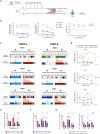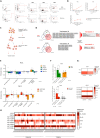Harnessing T cell exhaustion and trogocytosis to isolate patient-derived tumor-specific TCR
- PMID: 38039364
- PMCID: PMC10691777
- DOI: 10.1126/sciadv.adg8014
Harnessing T cell exhaustion and trogocytosis to isolate patient-derived tumor-specific TCR
Abstract
To study and then harness the tumor-specific T cell dynamics after allogeneic hematopoietic stem cell transplant, we typed the frequency, phenotype, and function of lymphocytes directed against tumor-associated antigens (TAAs) in 39 consecutive transplanted patients, for 1 year after transplant. We showed that TAA-specific T cells circulated in 90% of patients but display a limited effector function associated to an exhaustion phenotype, particularly in the subgroup of patients deemed to relapse, where exhausted stem cell memory T cells accumulated. Accordingly, cancer-specific cytolytic functions were relevant only when the TAA-specific T cell receptors (TCRs) were transferred into healthy, genome-edited T cells. We then exploited trogocytosis and ligandome-on-chip technology to unveil the specificities of tumor-specific TCRs retrieved from the exhausted T cell pool. Overall, we showed that harnessing circulating TAA-specific and exhausted T cells allow to isolate TCRs against TAAs and previously not described acute myeloid leukemia antigens, potentially relevant for T cell-based cancer immunotherapy.
Figures




References
-
- M. M. Horowitz, R. P. Gale, P. M. Sondel, J. M. Goldman, J. Kersey, H.-J. Kolb, A. A. Rimm, O. Ringdén, C. Rozman, B. Speck, R. L. Truitt, F. E. Zwaan, M. M. Bortin, Graft-versus-leukemia reactions after bone marrow transplantation. Blood 75, 555–562 (1990). - PubMed
-
- J. Styczyński, G. Tridello, L. Koster, S. Iacobelli, A. van Biezen, S. van der Werf, M. Mikulska, L. Gil, C. Cordonnier, P. Ljungman, D. Averbuch, S. Cesaro, R. de la Camara, H. Baldomero, P. Bader, G. Basak, C. Bonini, R. Duarte, C. Dufour, J. Kuball, A. Lankester, S. Montoto, A. Nagler, J. A. Snowden, N. Kröger, M. Mohty, A. Gratwohl; Infectious Diseases Working Party EBMT , Death after hematopoietic stem cell transplantation: changes over calendar year time, infections and associated factors. Bone Marrow Transplant. 55, 126–136 (2020). - PMC - PubMed
-
- S. P. D’angelo, L. Melchiori, M. S. Merchant, D. Bernstein, J. Glod, R. Kaplan, S. Grupp, W. D. Tap, K. Chagin, G. K. Binder, S. Basu, D. E. Lowther, R. Wang, N. Bath, A. Tipping, G. Betts, I. Ramachandran, J.-M. Navenot, H. Zhang, D. K. Wells, E. Van Winkle, G. Kari, T. Trivedi, T. Holdich, L. Pandite, R. Amado, C. L. Mackall, Antitumor activity associated with prolonged persistence of adoptively transferred NY-ESO-1 c259T cells in synovial sarcoma. Cancer Discov. 8, 944–957 (2018). - PMC - PubMed
-
- A. G. Chapuis, D. N. Egan, M. Bar, T. M. Schmitt, M. S. McAfee, K. G. Paulson, V. Voillet, R. Gottardo, G. B. Ragnarsson, M. Bleakley, C. C. Yeung, P. Muhlhauser, H. N. Nguyen, L. A. Kropp, L. Castelli, F. Wagener, D. Hunter, M. Lindberg, K. Cohen, A. Seese, M. J. McElrath, N. Duerkopp, T. A. Gooley, P. D. Greenberg, T cell receptor gene therapy targeting WT1 prevents acute myeloid leukemia relapse post-transplant. Nat. Med. 25, 1064–1072 (2019). - PMC - PubMed
MeSH terms
Substances
Grants and funding
LinkOut - more resources
Full Text Sources
Medical
Molecular Biology Databases

